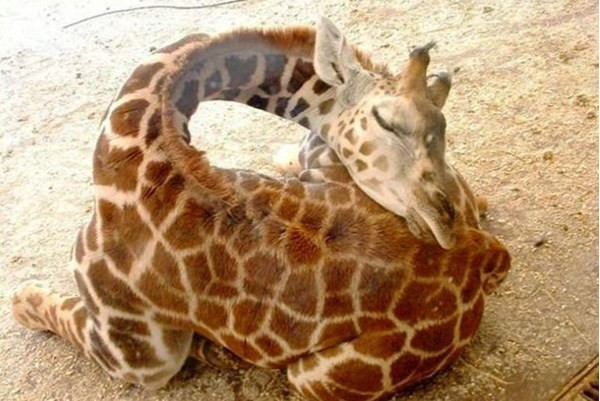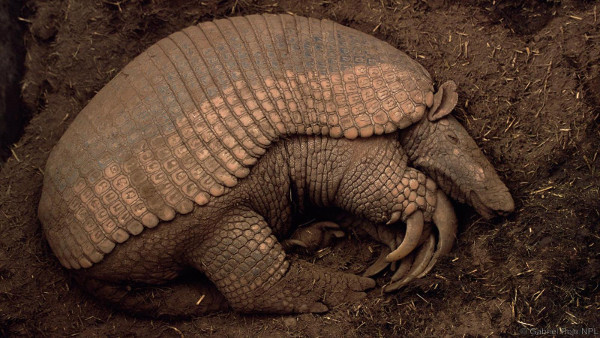The champions sleep in the animal world
Contrary to the usual default, the record of natural sleep time is not a lazy species.
Record of sleep time in the animal world
Animals sleep in many different ways. Sleep is a passive state of animals when they don't move much and muscles relax. However, some birds still fly when sleeping because only half of their brains participate in this activity.
"Sleep helps animals work more efficiently," said Dr. Jerome Siegel, director of the Sleep Research Center at the University of California, Los Angeles, USA. Some animals sleep more than others and follow Siegel, depending on how much time they spend eating.

Giraffes only sleep 5-10 minutes a day.(Photo: attackofthecute).
In general, herbivores sleep less than carnivores because they need more time to chew food in order to get enough energy . This is especially true for large herbivores like giraffes. In the 1970s, scientists observed that giraffes in their natural environment only slept for up to 30 minutes a day.
Sleep is also a defense mechanism."The vulnerable animals have little sleep time to focus on defending against the enemy," said Dr. John Lesku of La Trobe University, Melbourne, Australia. In contrast, predators spend less time defending themselves, especially when they live in groups. Lions are famous for their long-lying habits. They usually sleep 10 - 15 hours a day in captivity.
The giant pangolin (Priodontes maximus) lists many animals that sleep heavily because they usually sleep an average of 18 hours a day in soil pits.

Giant Pangolin sleeps 18 hours a day in a pit.(Photo: NPL).
According to a study of koala bear activity in Victoria, Australia, they sleep about 14.5 hours a day and spend nearly 5 more hours resting due to eucalyptus, their food, providing less energy and It takes time to digest.
According to Lesku, two species that hold the current record of sleeping time are hairy pangolin (Chaeophractus villosus) for 20.4 hours a day and small mice who sleep 20.1 hours a day.
"Some animals are put into experimental environments and studied in new environments with available food , " Lesku said. In 1969, a small brown bat (Myotis lucifugus) was studied this way and became the longest sleeping species. It has closed eyes throughout 19.9 on a 24-hour total. However, the bat clings to a computer instead of the ceiling ceiling and the room temperature is also adjusted. It may not actually sleep but falls into a special state called lethargy .
Many animals can fall asleep to save energy. When the temperature is low, animals such as bats fall into a sleepy state called hibernation and when the temperature is high, this sleep state is called summer sleep.
Some animals fall asleep every day. According to a study in 2014, American weasels and Opossum mice slept an average of 14 hours a day.
Lethargy is different from sleep. It is like the body's inactive state : low metabolic rate and body temperature, and a significant reduction in brain activity to save energy.

He spends 40% of the time a day sleeping.(Photo: National Geographic).
To test the true sleep activity of the wild animal brain, scientists conducted research on sloths, the most famous day-sleeping species. They slept more than 15 hours a day but research in Panama in 2008 indicated they slept less than 10 hours a day. However, taking 40% of the time a day to rest is a relatively large number, especially for species that eat only leaves and fruits, and are more likely to be prey to cheetahs or eagles.
- Find the most cruel animal in the world
- Extraordinary sleeping habits in animals
- Sleep affects the color of the owl?
- Are any animals not sleeping well?
- Scientists discovered the least sleeping animal
- How do the animals sleep?
- The reason people have to sleep
- Sleeping a lot also causes illness
- Decode the phenomenon of saying dream when sleeping
- 5 reasons why you sleep more than 10 hours a day and still yawn
- Animal world and strange things
- 30 facts about sleep
 Animal 'suffering' after hibernation
Animal 'suffering' after hibernation Why do goats climb well?
Why do goats climb well? Scientists were surprised to see chimpanzees eating turtles
Scientists were surprised to see chimpanzees eating turtles Giant catfish died deadly due to drought in Thailand
Giant catfish died deadly due to drought in Thailand